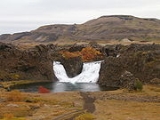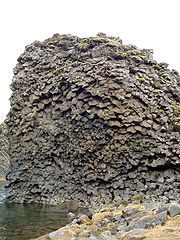
Hjálparfoss
Encyclopedia



Stratovolcano
A stratovolcano, also known as a composite volcano, is a tall, conical volcano built up by many layers of hardened lava, tephra, pumice, and volcanic ash. Unlike shield volcanoes, stratovolcanoes are characterized by a steep profile and periodic, explosive eruptions...
Hekla
Hekla
Hekla is a stratovolcano located in the south of Iceland with a height of . Hekla is one of Iceland's most active volcanoes; over 20 eruptions have occurred in and around the volcano since 874. During the Middle Ages, Icelanders called the volcano the "Gateway to Hell."Hekla is part of a volcanic...
near the point where the rivers Fossá and Þjórsá
Þjórsá
Þjórsá is Iceland's longest river at 230 kilometers. It is in the southern region of the island.Þjórsá is a glacier river has its source on the glacier Hofsjökull. It flows out through narrow gorges in the highlands of Iceland. Further downstream, another river, the Tungnaá, flows into it , before...
join. Hjálparfoss is located about 30 kilometres (18.6 mi) east of the village Flúðir
Flúðir
Flúðir is a small village located in the Hrunamannahreppur municipality in the region of Suðurland, Iceland.It is not far from Geysir and the Gullfoss waterfall. It has a population of 394.-References:...
and can be reached by a gravel road off Route 32 that winds through the Vikrar lava fields. About 5 kilometres (3.1 mi) south of Hjálparfoss lies Þjófafoss
Þjófafoss
Þjófafoss is located on the river Þjórsá on the east side of the Merkurhraun lava fields in the south of Iceland, at the southwest tip of the hill Búrfell...
; further east are Háifoss
Háifoss
The waterfall Háifoss is situated near the volcano Hekla in the south of Iceland. The river Fossá, a tributary of Þjórsá, drops here from a height of 122 m...
on the Fossá and Tangafoss on the Þjórsá.
Just downstream from Hjálparfoss is Iceland's second-largest hydroelectric power station
Icelandic hydroelectric power stations
Over 80% of electricity in Iceland is generated in hydroelectric power stations. While geothermal energy is used for heating , the hydroelectric power stations, historically all run by Landsvirkjun, are central to the existence of Iceland as an industrialized country.The largest power station by...
, Búrfellsstöð.
External links
- Information on Búrfellsstöð from LandsvirkjunLandsvirkjunLandsvirkjun is the largest energy producer in Iceland. It was founded in 1965 by the city of Reykjavík and the state of Iceland. Its general purpose is to produce and provide electricity for heavy industry and to sell electricity to local providers around Iceland...
(in Icelandic) - Images of Hjálparfoss on FlickrFlickrFlickr is an image hosting and video hosting website, web services suite, and online community that was created by Ludicorp in 2004 and acquired by Yahoo! in 2005. In addition to being a popular website for users to share and embed personal photographs, the service is widely used by bloggers to...

